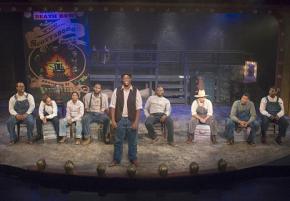Vaudeville and sorrow
reviews a play about the case of the Scottsboro Boys, nine Black youth who were falsely accused of raping two white women in the 1930s U.S. South.
VAUDEVILLE--WITH its exaggerated characterizations, over-the-top costumes, jokes, and elaborate song and dance--may seem like a strange genre choice for a play about racism, incarceration and the injustice of the criminal justice system. But in Direct from Death Row The Scottsboro Boys, a new play running at Raven Theater in Chicago, vaudeville is combined with drama to produce a moving, engaging and entertaining performance.
The play, told from the point of view of the nine Scottsboro Boys themselves, is both brutal and solemn, and even hard to watch at times. But interspersed throughout are uproariously funny bits, involving cartoonish masks, dance numbers and magic tricks, which bring to light true aspects of the case in their own way.
The vaudeville portions of the play highlight the spectacle that was made of the Scottsboro Boys' case, and show how outrageous and farcical the so-called justice system was. Meanwhile, the more somber parts of the play show the devastating impact of this farce on the Black youth who were caught in the middle.

Stellar performances by an all-Black cast make the play a thrill to watch. Almost all play multiple roles. Each actor plays one of the nine Scottsboro Boys, and most also change into mask and costume to depict the other characters in the play, including the lawyers, jurors, and judges, the Communist Party (CP) and NAACP representatives, the Scottsboro mothers, and the women who accused the men of rape.
With three women as part of the cast, the play also includes groundbreaking cross-gender casting. Through all this, the play manages to keep the Scottsboro Boys' stories at the center without avoiding the political questions.
THE PLAY starts by introducing the nine Scottsboro Boys, who begin by recounting what happened on the train between Chattanooga and Memphis, Tennessee on March 25, 1931. The youth, aged 13 to 19 at the time, had been among many poor Black and white train hoppers who were riding the rails that night.
While their reasons for being on board differ--several were seeking work, others were headed home or going after a lost love or seeking medical care--these strangers found themselves on the same train car that night. Or rather, seven of them were on the same train car. Two were several cars over and had never seen the other defendants nor the women who accused them of rape until after they were arrested.
At some point, a fight broke out on the train between some of the Black and white train hoppers (a couple of whom, unbeknownst to most, turned out to be women). Several of the white passengers, who lost the fight, were tossed from the train, and they alerted the authorities. By the time the train pulled in at the next station, police were there to make arrests.
In the play, the teenagers said that they had expected to be apprehended because of the fight or for being on the train illegally. What they didn't expect, however, was to be accused of rape by Victoria Price and Ruby Bates, two white female train hoppers who they had not even noticed before.
While we can't know exactly why Price and Bates made their accusations, the play does suggest several motivations. What is clear, however, is that the two women's stories held no water. Nevertheless, the nine accused teenagers were brought to a prison in Scottsboro, Alabama, where they were confronted with a racist mob, police brutality and degradation.
Over the course of the next several years, the Scottsboro Boys would face trial four times together--always with all-white juries--and would be convicted every time, despite enormous gaps and contradictions in the case. The actors in the play use actual court transcripts to depict these scenes and remind the audience several times over that they are verbatim. Nevertheless, it is difficult to distinguish the ridiculousness of the actual speech from the masks and costumes and exaggerated mannerisms that the characters display.
After the first trial, the case attracted the attention of both the CP and the NAACP, representatives of which visited the Scottsboro Boys to try to offer support. Since the play is told from the Scottsboro Boys' point of view, we get only glimpses of the work that each of these two organizations did. We know that the case has garnered public attention, and we hear some talk of mass rallies organized by the CP and of the Supreme Court case pushed forward by the NAACP.
The play also presents the debates being had out between the CP and NAACP, between the two organizations and the families, and even between the prisoners themselves. At the heart of these debates were questions about whether it was better to work within the system or to overthrow it, about whether a life sentence was better than a death sentence, about the importance of mass rallies and public pressure.
In the end, the play does not take a firm stand on these debates. What it does do is show the extent of the gross injustice that these young men faced and humanize their experiences. The Scottsboro Boys themselves are not presented as perfect, but as real people with personalities and disagreements. We see their lives as they unfold in the prison, where several of them effectively grew up. And we see the destructive impact that prison had on their lives when they were finally released years later.
Billed as "an evening of vaudeville and sorrow," the play will guide you through a rollercoaster of emotions, and teach a bit about the country's long history with racism and some of its most famous victims. Direct from Death Row The Scottsboro Boys is a must-see for anyone who cares to fight against injustice.


